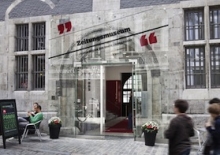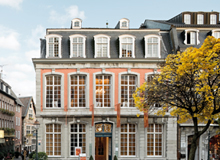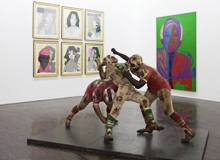The special collections feature remarkable examples of Attic vase painting and a range of different vessel types from amphoras to ointment pots. In addition to everyday utensils, jewellery and several statuettes of gods, the Egyptian collection also boasts fragments of an Egyptian funerary boat. The special collections also include an extensive inventory of glass painting and a collection of coins.
The museum's special collections include an extensive inventory of glass painting. For example, the permanent exhibition features painted glass windows and fragments from the Late Middle Ages with figurative and ornamental motifs. Panes from the Renaissance and the Baroque period portray Christian and worldly topics including depictions from the world of the Fuggers, for example the so-called "Swiss panes" from the 16th century.
The collection also features works by the likes of Johan Thorn-Prikker, Heinrich Campendonk, Ewald Mataré or Anton Wendling. In the 1920s, these artists revived the old technique of glass window design involving mosaicing rather than painting onto the glass pane. In their works from the "Era of Renewal", they used brilliant, clear antique glass.
It was after 1945 that the large slab glass windows set in concrete created by artists like Pierre Soulages, Raoul Ubac, Victor Vasarely, Robert Sowers, Otto Dix, Anton Wendling, Fritz Winter, Georg Meistermann, Johannes Schreiter and Ludwig Schaffrath appeared.
> On show on the 2nd floor
Ointment pots and funerary figurines – in addition to everyday utensils, jewellery and several statuettes of gods, the ancient Egyptian collection also boasts fragments of an Egyptian funerary boat. But the best example of the funerary practices of the ancient Egyptians is a richly illustrated receptacle for a mummy (6th century BC). The museum's female mummy (16th century BC) with mask, fragments of the receptacle and painted sarcophagus spent many years away from Aachen in the Röntgen-Museum (X-Ray Museum) in Remscheid and is currently on leave as a long-term loan to the Parque de la Cienas Museum in Cordoba.
> Not currently on show
The museum's extensive collection of artefacts from antiquity is represented in the permanent exhibition by remarkable examples of Attic vase painting and a range of different vessel types from amphoras to ointment pots. These works reflect the chronological development of the early Geometric period (900-700 BC) through the Archaic period (700-500 BC) to the Classical period (470-380 BC). The selection is rounded off with some small ceramic figurines: delicate terracotta figures from Tanagra (4th-3rd century BC) and Archaic-style figures of idols from Boeotia (6th-5th century BC).
The most prominent exhibits include two Apulian prize amphoras in Panathenaic style, a hub-of-the-world dish bowl, an apotropaic eye-cup and a bronze warrior's helmet from Olympia (550 BC). Another outstanding item is a bronze folding mirror with a depiction of Europa riding the bull.
The collection also has a section devoted to Coptic art of Late Antiquity – an encaustic portrait of a female mummy and a collection of almost 100 specimens of textiles – and a marble female head from the Central Roman Empire.
> Selection on show in the Tapestry Room on the 1st floor
The Suermondt Museum had an East-Asian cabinet which was almost completely destroyed in the Second World War. To compensate for the loss, in the 1950s the museum acquired a rich collection of Japanese sword guards – tsuba – from Japanese samurai swords. The majority of these iron discs, gold-plated or encrusted with jewels, date from the 17th-19th century and feature reliefs with figurative, mythological or floral motifs.
> Most of the East-Asian collection is not currently on show
On show in the Couven Museum are examples from the municipal collection of Japanese and Chinese porcelain as well as a large-format Chinese print.
The municipal collection encompasses several thousand items and contains a virtually complete collection of coins minted or used in Aachen from the Early Middle Ages to the present day, with lots of rarities and unique specimens. The inventory also boasts a small collection of Greco-Roman coins, coins acquired through archaeological digs in the Aachen region (primarily from Roman times and the Middle Ages) and an extensive collection of medals and plaques with regional relevance. And the collection also features some practical equipment relating to coinage: a mint press, coin scales, Ferdinand I's purse for coins to throw to the populace, forms of emergency currency …
> Not currently on show

Medienmuseum, Wechselausstellungen und eine Sammlung von 200.000 Zeitungen und Druckwerken in nahezu allen Sprachen.

Das bekannteste Wohnzimmer Aachens, mit anschaulichen Einblicken in die Wohnkultur des 18. und frühen 19. Jahrhunderts.

UNESCO-Weltkulturerbe mit herausragender künstlerischer Ausstattung: Karlsschrein, aufwändigen Mosaiken, einer goldenen Altartafel.

Die größten Historienbilder der Romantik, originalgetreue Kopien des Säbels Karls des Großen, einer karolingischen Handschrift, der Reichskrone.

Kunst von der Gegenwart bis in die Antike, mit hervorragenden Gemälden und Skulpturen des Spätmittelalters sowie der Malerei des 17. Jhs.

Schauplatz für zeitgenössische Künstler und Kunstwerke, Begegnungsstätte darstellender und bildender Kunst, Bestände der Sammlung Ludwig.

Lebendiges Zentrum zur Erinnerung der Grenzgeschichte und -geschichten, mit verbotenen Souvenirs und Schwarzbrennerei.

Eröffnung 2014 – Lebendige Geschichte von den Karolingern bis heute. Ausgangspunkt der Route Charlemagne am historischen Katschhof.

Stolz blicken die Aachener auf ihre Geschichte als römische Bäderstadt und Kaiserresidenz Karls des Großen zurück. Der Dom, 1978 zum ersten UNESCO Weltkulturerbe in Deutschland ernannt, und das Rathaus bilden den Mittelpunkt der Stadt. In den Gassen der Altstadt erzählen viele historische Gebäude von der lebhaften Geschichte der Stadt, und doch ist die Zeit nicht stehen geblieben.
An der „Eliteuni“ RWTH Aachen und den anderen Hochschulen sind rund 40.000 Studenten eingeschrieben. Das junge Leben pulsiert vor allem im Pontviertel, dem beliebten Ausgehviertel mit seinen zahlreichen Cafés, Kneipen und Restaurants. Doch auch in den Gassen und auf den Plätzen der Altstadt ist immer viel los. Rund um Dom und Rathaus laden zahlreiche Einzelhändler ebenso wie Filialen namhafter Häuser zum Bummeln ein.
Quelle allen Ruhms ist das Wasser: Die Heilkraft der heißen Thermalquellen war ausschlaggebend dafür, dass Kaiser Karl Aachen zu seiner Lieblingsresidenz machte. Die Badetradition wird heute durch die Carolus Thermen Bad Aachen weitergeführt.
Wer sich lieber in der Natur entspannt, hat dafür zahlreiche Möglichkeiten, etwa im nahe gelegenen Nationalpark Eifel. Zudem locken mehrere Theater und Museen mit einem vielschichtigen Angebot.

